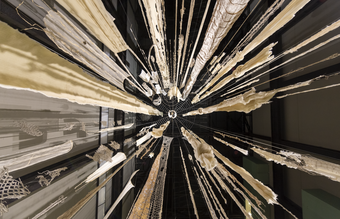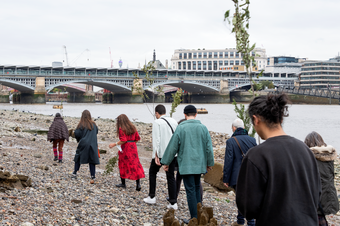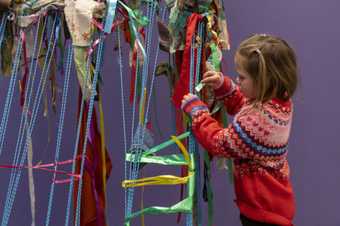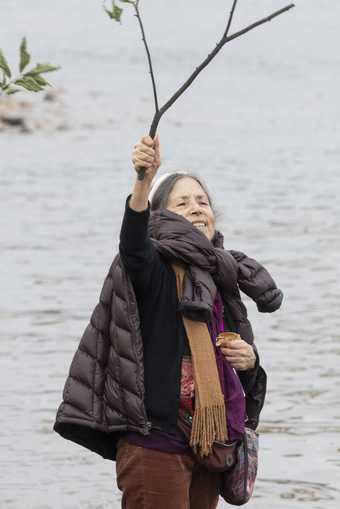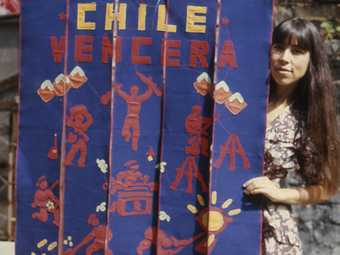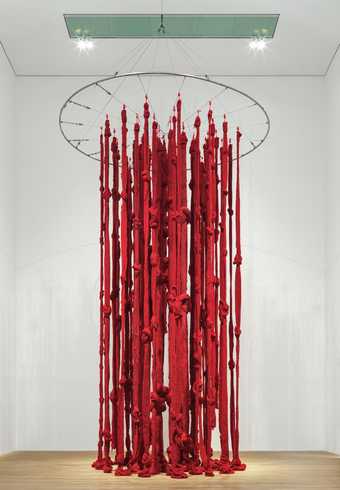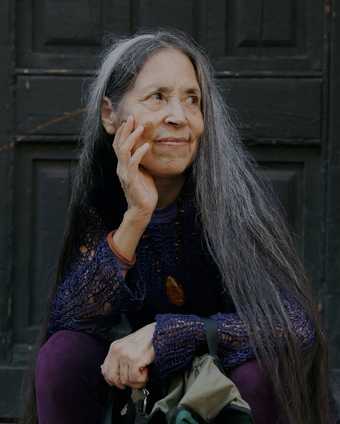Tate declared a climate and ecological emergency in July 2019, recognising the unique role art and art museums can play in creating fundamental societal change. Through reduction activities, Tate are committed to reducing their carbon emissions by 50 per cent by 2023 from the baseline year of 2007/8 and are working toward a net zero target in 2030. This analysis supports Tate’s pledge to educate patrons and raise awareness of the climate and ecological emergency through collaboration and communicating programme impacts.
Greenhouse Gas Emissions
The greenhouse gas emissions associated with this commission were estimated using the framework of the World Resource Institute’s Greenhouse Gas Protocol. Calculations utilise emission factors sourced from the United Kingdom’s ‘Greenhouse Gas Reporting: Conversion Factors 2022’ data, as well as other factors from a variety of lifecycle assessment studies. Data included in this review is reported in units of tonnes of carbon dioxide equivalents, or tonnes CO2e. Carbon dioxide equivalents by mass are the standard used for calculating greenhouse gas emissions, as different greenhouse gases affect the climate with different intensity.
How Much is 1 tonne of CO2e?
Tonnes CO2e is the primary unit of measure for greenhouse gas emissions, so it is important to contextualise its meaning in terms of everyday activities. The examples below have been calculated using the UK GHG Conversion Factors 2022 data set.
1 tonne of CO2e is equivalent to the GHG emissions from:
- Driving an average petrol car 5,800 km
- Recharging an electric vehicle 129 times
- Flying from London to Edinburgh 7.5 times
Assumptions
This review follows the framework of the World Resource Institute’s Greenhouse Gas Protocol, in which emissions are analysed for direct, indirect and supply chain sources. Each emissions category is titled using common terminology and provides the relevant categorisation within Greenhouse Gas Protocol guidance. This analysis uses the best available information sourced from staff, suppliers, government entities, and research bodies to estimate the carbon footprint of this work to provide viewers with the information to consider the impact of this commission, and to more acutely understand how their lifestyle impacts the planet. Most emission factors used in this analysis are from the “UK Greenhouse Gas Reporting: Conversion Factors 2022”, while additional factors have been sourced from scientific journals and research.
As most of the coordination of this display is associated with acquiring goods and services from third parties, the data available is not fully comprehensive. At the time of publication, the project was not able to accurately include visitor travel, transportation of materials to Tate Modern, emissions associated with installation, staff commutes, related events, among other areas.
Carbon Footprint Summary
The estimated carbon footprint of this commission, assuming that the work will be transported back to New York by cargo vessel, is 47.9 tonnes CO2e. For comparison, the emissions from all Tate facilities were reported as 9,367 tonnes CO2e for 2020/21 annual accounts reporting.
In terms of relative impacts, artwork material sourcing travel is the most significant emitting activity followed by business travel, catalogues, and electricity consumption of the commission. More detailed information is provided by the emitting category below.
Artwork Materials
Scope 3, Category 1: Purchased Goods and Services
All materials have a carbon footprint based on primary resource production, transportation, processing, and more. This analysis utilises emission factors from the United Kingdom in parallel with lifecycle assessment factors for more unique products such as hemp or cotton in order to estimate the carbon emissions associated with this commissioned work.
To reduce associated climate and sustainability impacts, the materials for this artwork have been selected by the artist and curation team with a preference for materials that are organic, plastic-free, non-toxic, and from vendors local to the United Kingdom.
This section of analysis accounts for ‘Cradle-to-Gate’ emissions, which include primary material extraction, primary processing, manufacturing, and transportation for each material on a weight basis. In total, the cradle-to-gate emissions associated with the materials used for the artwork amounts to approximately 27.7 tonnes CO2e. Over 3,500 kg of engineered steel was used in the creation of this work and is the largest contributor to these emissions. This underlying structure provides the framework upon which the material elements were placed and was manufactured to conform with strict safety and engineering specifications. The other largest contributors to the materials carbon footprint are the hemp and fabrics based on the quantity of materials required to develop a commission on this scale.
Business Travel
Scope 3, Category 6: Business Travel
Scope 3, Category 3: Fuel & Energy-Related Activities
Emissions resulting from travel are often one of the largest sources of greenhouse gas emissions for art exhibitions, primarily as a result of the frequent air travel required in the coordination of a display. At the time of publication, 8 flights, 8 train rides, and 5 vehicle rides have been accounted for, with 10 more flights anticipated in support of the commission. Through expanded use of teleconference tools, Tate and the artist have reduced the amount of travel required in comparison to prior commissions.
By the end of this commission, the artist and support staff will have travelled over 60,000 km by plane, 5,000 km by rail, and 100 km by vehicle, resulting in an estimated 17.4 tonnes CO2e of greenhouse gases emitted. This estimate also includes the emissions associated with the lifecycle of fuel and electricity consumed to enable travel - described by the term ‘Well-To-Tank” (WTT).
Note that this impact only accounts for the personnel directly involved in this commission and does not include an estimate for emissions associated with patrons travelling to Tate Modern to view the commission. Visitor emissions are commonly the largest source of emissions related to an art institution’s carbon footprint.
Catalogue Printing and End Use
(Scope 3, Category 1: Purchased Goods and Services / Category 12: End of Life Treatment of Sold Products)
1,500 copies of this catalogue have been printed, requiring approximately 735 kg of paper. These catalogues were printed using a Heidelberg Druckmaschinen industrial printer, which draws on average 133.5 kilowatts of power. When considering the cradle-to-gate emissions for the paper and the emissions from the consumed electricity (including considerations for the lifecycle of that electricity), the catalogues have an estimated carbon footprint of 1.1 tonnes CO2e.
The UK Department for Environment, Food and Rural Affairs (DEFRA) estimates that 80% of paper in the UK is recycled while 20% is sent to landfill. Using these percentages as a guide, we estimate that the end use of these catalogues if they are discarded to recycling and landfill will result in emissions of approximately 0.2 tonnes CO2e. According to DEFRA factors, the landfilling of paper products emits 49 times more carbon than when the paper is recycled, so please consider this information when managing this catalogue.
Artwork Energy Consumption
Scope 2: Indirect Emissions from Supplied Electricity
Consumption of electricity results in the emissions of greenhouse gases from power generation. This section considers the electricity consumed exclusively associated with the commission and does not include lighting fixtures that are routinely used.
The audio system supplementing the artwork draws about 1,600 watts of power. The AV equipment is anticipated to operate for 12 hours per day over the course of the 187-day commission display, which will amount to approximately 3,600 kilowatt-hours of electricity consumed, resulting in 0.9 tonnes CO2e of GHG emissions. This figure includes the emissions associated with fuel consumption in generation as well as losses through transmission and distribution.
Considerations for the Close of Commission
At the time of publication, a decision was made that after the close of the commission in 2023 the materials composing the artwork would be retained and returned to New York City by sea. This section analyses the case in which the artwork returns to New York City.
Transport
Scope 3, Category 9: Downstream Transportation & Distribution
After the close of the commission, the work will be transported back to New York. It will move by heavy goods vehicle to the Port of Tilbury, where it will disembark on a cargo vessel bound for the Port of New York. Another heavy goods vehicle will pick up the work and transport it to a storage facility. In total, this shipping process will result in an estimated 0.7 tonnes CO2e of GHG emissions.
Shipping the work by freight vessel was chosen as an alternative to air freight, as it has a significantly lower impact due to the gained efficiency of moving goods in bulk at a slower pace. By shipping the work via freight vessel, an estimated 31.1 tonnes CO2e of emissions will be avoided.
In Support of Climate Action
This report was produced in partnership with the US-based consultancy, Co2Action. Co2Action focuses on helping clients demystify the quantitative aspects of sustainability and climate change, and supports clients in developing educational programs, greenhouse gas inventories, and roadmaps for emissions reduction.



